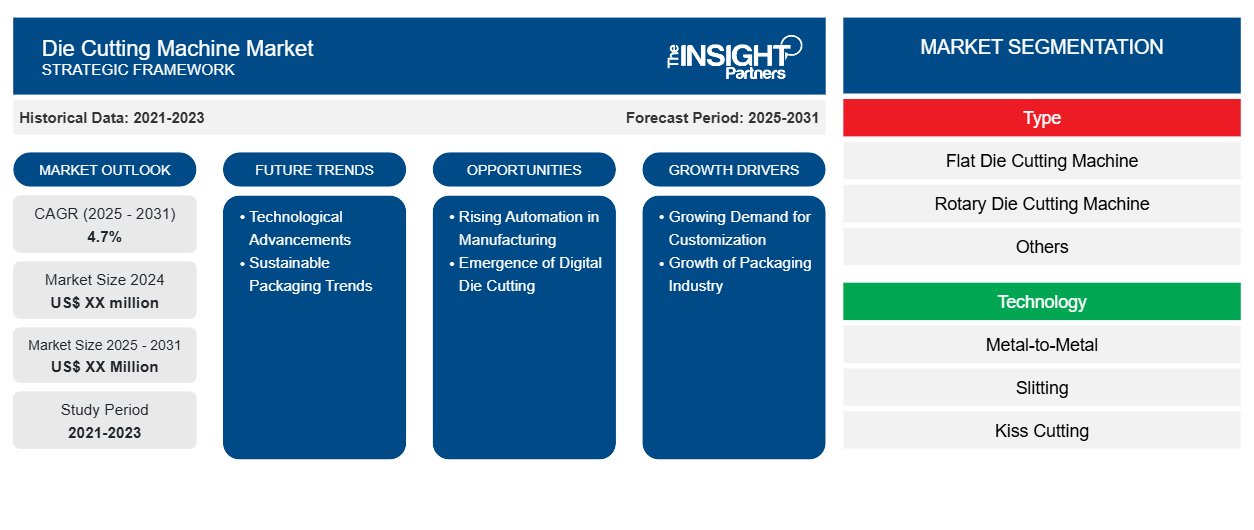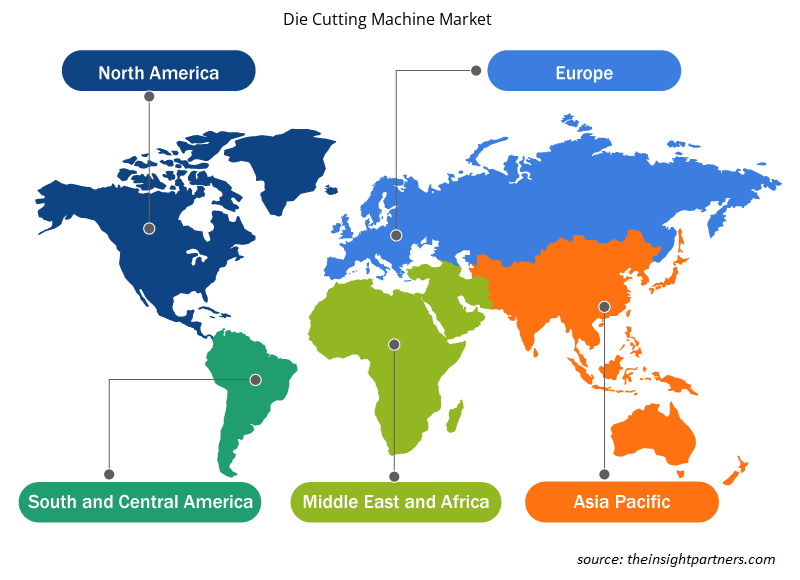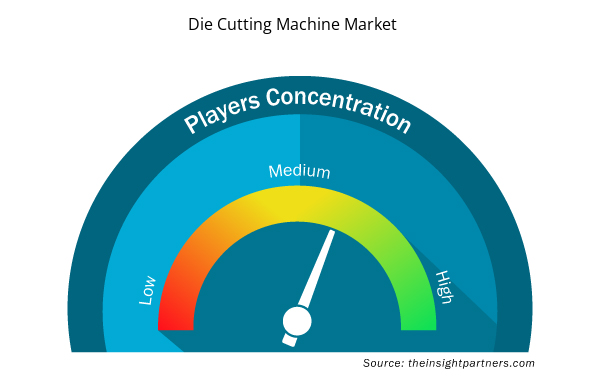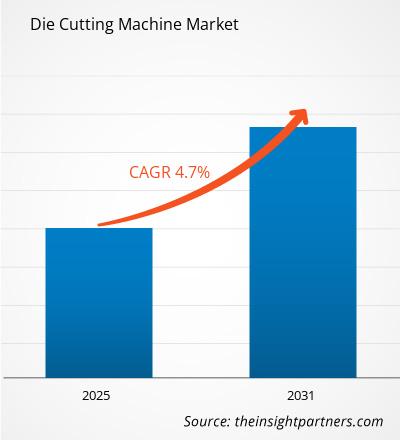Für den Markt für Stanzmaschinen wird von 2025 bis 2031 eine durchschnittliche jährliche Wachstumsrate (CAGR) von 4,7 % erwartet, wobei die Marktgröße von XX Millionen US-Dollar im Jahr 2024 auf XX Millionen US-Dollar im Jahr 2031 anwachsen wird.
Der Bericht ist nach Typ (Flachstanzmaschine, Rotationsstanzmaschine, Sonstige) segmentiert. Er enthält außerdem Analysen basierend auf der Technologie (Metall-Metall, Längsschneiden, Kiss-Cutting, Rillen). Der Bericht enthält außerdem Analysen basierend auf der Branchenvertikale (Pharmazie, Textil, Automobilindustrie, Fertigung, Sonstige). Die globale Analyse ist weiter nach Regionen und wichtigen Ländern unterteilt. Der Bericht bietet den Wert in USD für die oben genannten Analysen und Segmente.
Zweck des Berichts
Der Bericht „Stanzmaschinenmarkt“ von The Insight Partners beschreibt die aktuelle Marktsituation und das zukünftige Wachstum sowie die wichtigsten Treiber, Herausforderungen und Chancen. Er liefert Einblicke für verschiedene Geschäftsinteressenten, wie zum Beispiel:
- Technologieanbieter/-hersteller: Um die sich entwickelnde Marktdynamik zu verstehen und die potenziellen Wachstumschancen zu kennen, können sie fundierte strategische Entscheidungen treffen.
- Investoren: Durchführung einer umfassenden Trendanalyse hinsichtlich der Marktwachstumsrate, der finanziellen Marktprognosen und der Chancen entlang der Wertschöpfungskette.
- Regulierungsbehörden: Sie regulieren Richtlinien und polizeiliche Aktivitäten auf dem Markt mit dem Ziel, Missbrauch zu minimieren, das Vertrauen der Anleger zu bewahren und die Integrität und Stabilität des Marktes aufrechtzuerhalten.
Marktsegmentierung für Stanzmaschinen
Typ
- Flachstanzmaschine
- Rotationsstanzmaschine
- Sonstiges
Technologie
- Metall auf Metall
- Schlitzen
- Kussschnitt
- Wertung
Branchenvertikale
- Pharmazeutische
- Textil
- Automobil
- Herstellung
- Sonstiges
Geographie
- Nordamerika
- Europa
- Asien-Pazifik
- Süd- und Mittelamerika
- Naher Osten und Afrika
Passen Sie diesen Bericht Ihren Anforderungen an
Sie erhalten kostenlos Anpassungen an jedem Bericht, einschließlich Teilen dieses Berichts oder einer Analyse auf Länderebene, eines Excel-Datenpakets sowie tolle Angebote und Rabatte für Start-ups und Universitäten
Markt für Stanzmaschinen: Strategische Einblicke

- Informieren Sie sich über die wichtigsten Markttrends in diesem Bericht.Dieses KOSTENLOSE Beispiel umfasst eine Datenanalyse, die von Markttrends bis hin zu Schätzungen und Prognosen reicht.
Wachstumstreiber auf dem Markt für Stanzmaschinen
- Wachsende Nachfrage nach Individualisierung: Der Haupttreiber für den Markt für Stanzmaschinen ist die steigende Nachfrage nach kundenspezifischen Verpackungen, Textilien und der Automobilindustrie. Stanzmaschinen sind Allzweckwerkzeuge, die das schnelle Stanzen spezifischer Formen und Designs ermöglichen. Diese Anforderungen sind heute unabdingbar, um Kundenwünsche zu erfüllen und so die Attraktivität des Produkts zu steigern.
- Wachstum der Verpackungsindustrie: Das Wachstum der Verpackungsindustrie, insbesondere in den Bereichen Lebensmittel, Getränke, Pharma und Konsumgüter, trägt zweifellos maßgeblich zum Wachstum des Stanzmaschinenmarktes bei. Um die Verpackungseffizienz zu senken und gleichzeitig die Kosten zu senken, setzen Unternehmen verstärkt auf Stanzmaschinen zur Herstellung präziser und komplexer Verpackungsdesigns.
Zukünftige Trends auf dem Markt für Stanzmaschinen
- Technologischer Fortschritt: Darüber hinaus ergeben sich erhebliche Wachstumschancen durch technologische Fortschritte, wie beispielsweise digitale und automatisierte Stanzmaschinen, die präzisere und schnellere Abläufe ermöglichen. Daher bleiben sie für Hersteller, die eine bessere und optimierte Produktion anstreben, sehr attraktiv.
- Trends bei nachhaltigen Verpackungen: Nachhaltigkeit und umweltfreundliche Verpackungslösungen gewinnen zunehmend an Bedeutung. Daher wird auch die Nachfrage nach Stanzmaschinen, die die Grundlage für recycelbare und biologisch abbaubare Materialien bilden, durch den zunehmenden Fokus auf Nachhaltigkeit deutlich steigen.
Marktchancen für Stanzmaschinen
- Steigende Automatisierung in der Fertigung: Der Trend zur Automatisierung im Fertigungsprozess treibt den Markt für Stanzmaschinen maßgeblich voran. Automatisierte Stanzmaschinen sind heute weit verbreitet und gewährleisten hohe Produktionsraten und sparen Arbeitskosten. Das ist attraktiv für Hersteller, die produktiv sein wollen.
- Digitales Stanzen: Ein weiterer Trend auf dem Markt ist das digitale Stanzen. Digitale Stanzmaschinen bieten Flexibilität und schnellere Durchlaufzeiten bei kleinen Auflagen für Unternehmen, die schnelle Prototypen und individuelle Anpassungen benötigen.
Regionale Einblicke in den Markt für Stanzmaschinen
Die Analysten von Insight Partners haben die regionalen Trends und Faktoren, die den Markt für Stanzmaschinen im Prognosezeitraum beeinflussen, ausführlich erläutert. In diesem Abschnitt werden auch die Marktsegmente und die geografische Lage von Stanzmaschinen in Nordamerika, Europa, Asien-Pazifik, dem Nahen Osten und Afrika sowie Süd- und Mittelamerika erläutert.

- Erhalten Sie regionale Daten zum Markt für Stanzmaschinen
Umfang des Marktberichts über Stanzmaschinen
| Berichtsattribut | Details |
|---|---|
| Marktgröße im Jahr 2024 | XX Millionen US-Dollar |
| Marktgröße bis 2031 | XX Millionen US-Dollar |
| Globale CAGR (2025 - 2031) | 4,7 % |
| Historische Daten | 2021-2023 |
| Prognosezeitraum | 2025–2031 |
| Abgedeckte Segmente | Nach Typ
|
| Abgedeckte Regionen und Länder | Nordamerika
|
| Marktführer und wichtige Unternehmensprofile |
|
Marktteilnehmerdichte für Stanzmaschinen: Auswirkungen auf die Geschäftsdynamik
Der Markt für Stanzmaschinen wächst rasant. Die steigende Nachfrage der Endverbraucher ist auf Faktoren wie veränderte Verbraucherpräferenzen, technologische Fortschritte und ein stärkeres Bewusstsein für die Produktvorteile zurückzuführen. Mit der steigenden Nachfrage erweitern Unternehmen ihr Angebot, entwickeln Innovationen, um den Bedürfnissen der Verbraucher gerecht zu werden, und nutzen neue Trends, was das Marktwachstum weiter ankurbelt.
Die Marktteilnehmerdichte bezieht sich auf die Verteilung der Firmen oder Unternehmen, die in einem bestimmten Markt oder einer bestimmten Branche tätig sind. Sie gibt an, wie viele Wettbewerber (Marktteilnehmer) in einem bestimmten Marktraum im Verhältnis zu seiner Größe oder seinem gesamten Marktwert präsent sind.
Die wichtigsten Unternehmen auf dem Markt für Stanzmaschinen sind:
- BOBST
- Cerutti-Gruppe
- DeltaModTech
- Duplo Corporation
- Hannan Products Corporation
Haftungsausschluss : Die oben aufgeführten Unternehmen sind nicht in einer bestimmten Reihenfolge aufgeführt.

- Überblick über die wichtigsten Akteure auf dem Markt für Stanzmaschinen
Wichtige Verkaufsargumente
- Umfassende Abdeckung: Der Bericht deckt die Analyse von Produkten, Dienstleistungen, Typen und Endbenutzern des Stanzmaschinenmarktes umfassend ab und bietet eine ganzheitliche Landschaft.
- Expertenanalyse: Der Bericht basiert auf dem umfassenden Verständnis von Branchenexperten und Analysten.
- Aktuelle Informationen: Der Bericht gewährleistet Geschäftsrelevanz durch die Berichterstattung über aktuelle Informationen und Datentrends.
- Anpassungsoptionen: Dieser Bericht kann angepasst werden, um spezifische Kundenanforderungen zu erfüllen und die Geschäftsstrategien optimal anzupassen.
Der Forschungsbericht zum Markt für Stanzmaschinen kann daher dazu beitragen, die Branchensituation und die Wachstumsaussichten zu entschlüsseln und zu verstehen. Obwohl es einige berechtigte Bedenken gibt, überwiegen die Vorteile dieses Berichts tendenziell die Nachteile.
- Historische Analyse (2 Jahre), Basisjahr, Prognose (7 Jahre) mit CAGR
- PEST- und SWOT-Analyse
- Marktgröße Wert/Volumen – Global, Regional, Land
- Branche und Wettbewerbsumfeld
- Excel-Datensatz


- Tortilla Market
- Quantitative Structure-Activity Relationship (QSAR) Market
- Vessel Monitoring System Market
- Vaginal Specula Market
- Data Annotation Tools Market
- Electronic Health Record Market
- Fish Protein Hydrolysate Market
- Smart Water Metering Market
- Constipation Treatment Market
- Artificial Intelligence in Defense Market

Report Coverage
Revenue forecast, Company Analysis, Industry landscape, Growth factors, and Trends

Segment Covered
This text is related
to segments covered.

Regional Scope
North America, Europe, Asia Pacific, Middle East & Africa, South & Central America

Country Scope
This text is related
to country scope.
Häufig gestellte Fragen
Some of the customization options available based on the request are an additional 3-5 company profiles and country-specific analysis of 3-5 countries of your choice. Customizations are to be requested/discussed before making final order confirmation, as our team would review the same and check the feasibility.
The report can be delivered in PDF/PPT format; we can also share excel dataset based on the request.
Rising Automation in Manufacturing and Emergence of Digital Die Cutting are the key future trends of the Die Cutting Machine Market
The leading players operating in the Die Cutting Machine Market include BOBST, Cerutti Group, DeltaModTech, Duplo Corporation, Hannan Products Corporation, Heidelberger Druckmaschinen AG, LARTEC-J, S.L., Sanwa, Yawa, Young Shin
The Die Cutting Machine Market is estimated to witness a CAGR of 4.7% from 2023 to 2031
The major factors driving the Die Cutting Machine Market are: Growing Demand for Customization and Growth of Packaging Industry
Trends and growth analysis reports related to Manufacturing and Construction : READ MORE..
1. BOBST
2. Cerutti Group
3. DeltaModTech
4. Duplo Corporation
5. Hannan Products Corporation
6. Heidelberger Druckmaschinen AG
7. LARTEC-J, S.L.
8. Sanwa
9. Yawa
10. Young Shin
The Insight Partners performs research in 4 major stages: Data Collection & Secondary Research, Primary Research, Data Analysis and Data Triangulation & Final Review.
- Data Collection and Secondary Research:
As a market research and consulting firm operating from a decade, we have published and advised several client across the globe. First step for any study will start with an assessment of currently available data and insights from existing reports. Further, historical and current market information is collected from Investor Presentations, Annual Reports, SEC Filings, etc., and other information related to company’s performance and market positioning are gathered from Paid Databases (Factiva, Hoovers, and Reuters) and various other publications available in public domain.
Several associations trade associates, technical forums, institutes, societies and organization are accessed to gain technical as well as market related insights through their publications such as research papers, blogs and press releases related to the studies are referred to get cues about the market. Further, white papers, journals, magazines, and other news articles published in last 3 years are scrutinized and analyzed to understand the current market trends.
- Primary Research:
The primarily interview analysis comprise of data obtained from industry participants interview and answers to survey questions gathered by in-house primary team.
For primary research, interviews are conducted with industry experts/CEOs/Marketing Managers/VPs/Subject Matter Experts from both demand and supply side to get a 360-degree view of the market. The primary team conducts several interviews based on the complexity of the markets to understand the various market trends and dynamics which makes research more credible and precise.
A typical research interview fulfils the following functions:
- Provides first-hand information on the market size, market trends, growth trends, competitive landscape, and outlook
- Validates and strengthens in-house secondary research findings
- Develops the analysis team’s expertise and market understanding
Primary research involves email interactions and telephone interviews for each market, category, segment, and sub-segment across geographies. The participants who typically take part in such a process include, but are not limited to:
- Industry participants: VPs, business development managers, market intelligence managers and national sales managers
- Outside experts: Valuation experts, research analysts and key opinion leaders specializing in the electronics and semiconductor industry.
Below is the breakup of our primary respondents by company, designation, and region:

Once we receive the confirmation from primary research sources or primary respondents, we finalize the base year market estimation and forecast the data as per the macroeconomic and microeconomic factors assessed during data collection.
- Data Analysis:
Once data is validated through both secondary as well as primary respondents, we finalize the market estimations by hypothesis formulation and factor analysis at regional and country level.
- Macro-Economic Factor Analysis:
We analyse macroeconomic indicators such the gross domestic product (GDP), increase in the demand for goods and services across industries, technological advancement, regional economic growth, governmental policies, the influence of COVID-19, PEST analysis, and other aspects. This analysis aids in setting benchmarks for various nations/regions and approximating market splits. Additionally, the general trend of the aforementioned components aid in determining the market's development possibilities.
- Country Level Data:
Various factors that are especially aligned to the country are taken into account to determine the market size for a certain area and country, including the presence of vendors, such as headquarters and offices, the country's GDP, demand patterns, and industry growth. To comprehend the market dynamics for the nation, a number of growth variables, inhibitors, application areas, and current market trends are researched. The aforementioned elements aid in determining the country's overall market's growth potential.
- Company Profile:
The “Table of Contents” is formulated by listing and analyzing more than 25 - 30 companies operating in the market ecosystem across geographies. However, we profile only 10 companies as a standard practice in our syndicate reports. These 10 companies comprise leading, emerging, and regional players. Nonetheless, our analysis is not restricted to the 10 listed companies, we also analyze other companies present in the market to develop a holistic view and understand the prevailing trends. The “Company Profiles” section in the report covers key facts, business description, products & services, financial information, SWOT analysis, and key developments. The financial information presented is extracted from the annual reports and official documents of the publicly listed companies. Upon collecting the information for the sections of respective companies, we verify them via various primary sources and then compile the data in respective company profiles. The company level information helps us in deriving the base number as well as in forecasting the market size.
- Developing Base Number:
Aggregation of sales statistics (2020-2022) and macro-economic factor, and other secondary and primary research insights are utilized to arrive at base number and related market shares for 2022. The data gaps are identified in this step and relevant market data is analyzed, collected from paid primary interviews or databases. On finalizing the base year market size, forecasts are developed on the basis of macro-economic, industry and market growth factors and company level analysis.
- Data Triangulation and Final Review:
The market findings and base year market size calculations are validated from supply as well as demand side. Demand side validations are based on macro-economic factor analysis and benchmarks for respective regions and countries. In case of supply side validations, revenues of major companies are estimated (in case not available) based on industry benchmark, approximate number of employees, product portfolio, and primary interviews revenues are gathered. Further revenue from target product/service segment is assessed to avoid overshooting of market statistics. In case of heavy deviations between supply and demand side values, all thes steps are repeated to achieve synchronization.
We follow an iterative model, wherein we share our research findings with Subject Matter Experts (SME’s) and Key Opinion Leaders (KOLs) until consensus view of the market is not formulated – this model negates any drastic deviation in the opinions of experts. Only validated and universally acceptable research findings are quoted in our reports.
We have important check points that we use to validate our research findings – which we call – data triangulation, where we validate the information, we generate from secondary sources with primary interviews and then we re-validate with our internal data bases and Subject matter experts. This comprehensive model enables us to deliver high quality, reliable data in shortest possible time.

 Holen Sie sich ein kostenloses Muster für diesen Bericht
Holen Sie sich ein kostenloses Muster für diesen Bericht